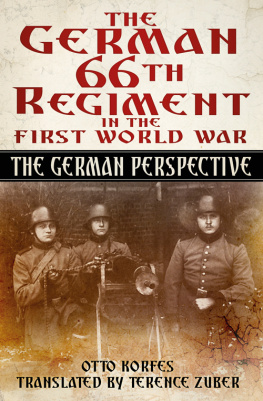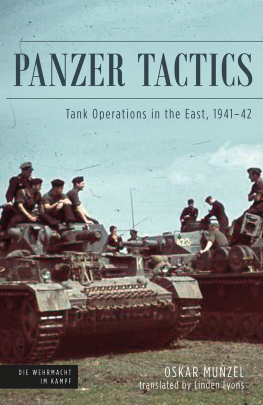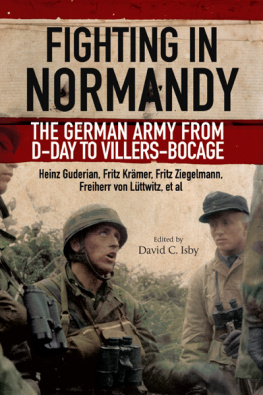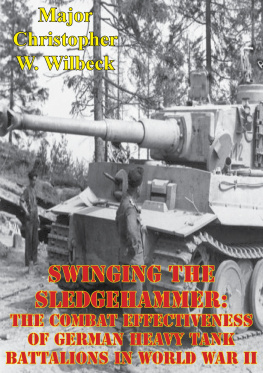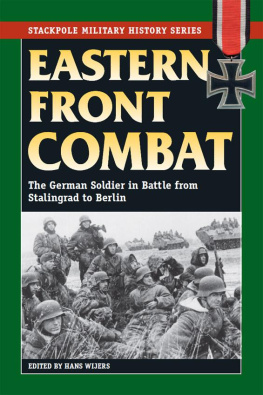


AN AUSA BOOK
Association of the United States Army
2425 Wilson Boulevard, Arlington, Virginia, 22201, USA
Published in the United States of America and Great Britain in 2021 by
CASEMATE PUBLISHERS
1950 Lawrence Road, Havertown, PA 19083, USA
and
The Old Music Hall, 106108 Cowley Road, Oxford OX4 1JE, UK
2021 Association of the U.S. Army
English translation 2021 Casemate Publishers
Originally published as Die Wehrmacht im Kampf 22: F. M. von Senger und Etterlin, Der Gegenschlag: Kamfbeispiele und Fhrungsgrundstze der Beweglichen Abwehr (Neckargemnd: Scharnhorst Buchkameradschaft, 1959)
Hardback Edition: ISBN 978-1-63624-080-0
Digital Edition: ISBN 978-1-63624-081-7
A CIP record for this book is available from the British Library
All rights reserved. No part of this book may be reproduced or transmitted in any form or by any means, electronic or mechanical including photocopying, recording or by any information storage and retrieval system, without permission from the publisher in writing.
Printed and bound in the United States by Integrated Books International
Typeset in India by Lapiz Digital Services, Chennai.
For a complete list of Casemate titles, please contact:
CASEMATE PUBLISHERS (US)
Telephone (610) 853-9131
Fax (610) 853-9146
Email:
www.casematepublishers.com
CASEMATE PUBLISHERS (UK)
Telephone (01865) 241249
Email:
www.casematepublishers.co.uk
Front cover: Sniper, Sixth Army, near Stalingrad, September 1942. (Bundesarchiv, Bild 169-0526)
This book is written in memory of my commander, comrade, and friend, HANS WILHELM VON HEYDEN, who fell in southern Ukraine on 22 February 1944 whilst in command of the 26th Panzer Grenadier Regiment (formerly the 22nd Cavalry Regiment) of the 24th Panzer Division.
Contents
by Matthias Strohn
Foreword
The common perception of the Wehrmacht in World War II has been formed by the early years of this conflict, when the German forces stormed across Europe and could only be stopped by the Red Army at the gates of Moscow in the winter of 1941. The concentration on these campaigns has often overshadowed the fact that the Wehrmacht fought defensively for large parts of the war, be it on the Eastern Front as it was trying to stop the Soviet steamroller, or on the Western Front. The fascination with offensive warfare is by no means restricted to World War II. Analysing the lessons of World War I, a German officer wrote in 1921 that to talk or write about the defensive is a thankless task only he who thinks, or seems to think, offensively, is thought to be a good soldier. Battles and campaigns are usually won by imposing ones will on the enemy and by keeping the initiative, which forces the opponent to react rather than act. The defence, in all its forms, is often seen as passive and reactive. However, this view is fundamentally wrong, and in this book, Ferdinand Maria Johann Fridolin von Senger und Etterlin shows the value of the flexible defence at the tactical level, which can break the enemys offensive power and thus prepare the ground for ones own offensive operations. In German military understanding, offensive action has always formed an integral part of the defence and is characterised by counter-strikes and hasty counter-attacks. The analysis of these lies at the heart of the book.
The book was first published in German in 1959, when the Cold War was in full swing. At the operational and tactical levels, it was always clear that a flexible defence would be necessary should the Cold War ever turn hot. This seemed to be the only chance for the numerically weaker, but technologically superior, NATO troops to stop an invasion by the Warsaw Pact. The book that you, the reader, hold in your hands has to be seen in this context. It is more than a mere historical study; it was intended to provide tangible lessons for NATO in order to prepare the alliance for the next major war. The comments about nuclear warfare in the book show that Senger und Etterlin was aware of the fact that things had changed. Nevertheless, he correctly stated that in the realm of conventional warfare, many of the lessons of World War II were still valid. The study also indirectly shows the value that the new Bundeswehr would bring to NATO. As the strongest European land force, the German Army would have had to bear the brunt of the fighting against the Soviet bloc, and the doctrine of the Bundeswehr in its early years showed very clear links to the experiences of World War II.
The book concentrates on tactical episodes of the war on the Eastern Front, in which the author took part, and it thus combines personal experience with doctrinal analysis. His personal experience had prepared Senger und Etterlin well for such a study. He was born in Tbingen in 1923, into a family with a long-standing military tradition. His father was Fridolin von Senger und Etterlin, who rose to General der Panzertruppe in World War II. The author of this book joined the army in 1940, and he gained most of his combat experience on the Eastern Front. He took part in Operation Barbarossa , the German invasion of the Soviet Union in 1941, and, in 1942, he was wounded during the battle of Stalingrad. He saw further action on the Eastern Front, and in August 1944 he was wounded during the second battle of Jassy-Kishinev, losing his right arm. This did not end his military career, though. He was transferred to the Army High Command (OKH) before being captured by American forces at the end of the war. After his release from captivity, he studied law in Gttingen, Zurich, and Oxford (where his father had studied, too) and gained a PhD. When the West German Bundeswehr was founded in 1955, he rejoined the colours and had a very successful second military career. He held a number of staff and command appointments and ended his time in uniform as commander in chief of Allied Forces Central Europe with the rank of full general. In addition to his practical military experience, von Senger und Etterlin was also a very active author. He wrote several books and numerous contributions to military magazines. He died in hlingen in 1987.
Prof. Matthias Strohn, M.St., DPhil., FRHistS
Head of Historical Analysis, Centre for Historical Analysis and Conflict Research, Camberley
Visiting Professor of Military Studies, University of Buckingham
Introduction
Mobile defence is a key term that tends to be understood as the antithesis of static defence, especially of the kind practiced by Hitler, and that is frequently regarded as the solution to the question of how a stronger attacker can be repulsed.
Static defence normally describes holding on to certain positions. Its proponents refer to examples in which stronger attackers were repelled by firmly held lines. It is up to military-historical research to ascertain whether this holds true. While the fight to hold such a line may be heroic, it seems that the value of so doing has been overestimated as far as obtaining success in operational defence is concerned.
This linear thinking has encroached on the way in which the nature of defensive operations should be viewed. In the natural course of the conduct of defensive operations, the defender initially delays the forward movement of the attacker and then brings him to a halt at a particular point in order to be able to launch a counter-strike that will destroy the enemy.
Next page


